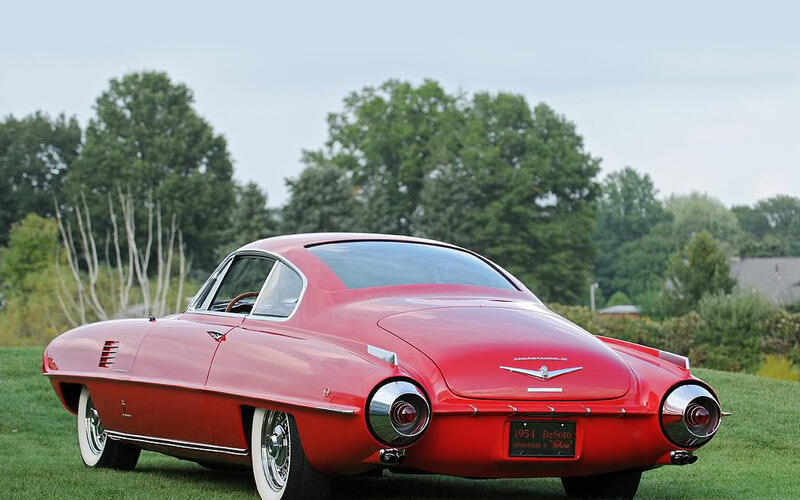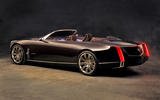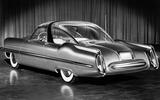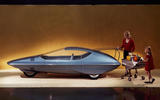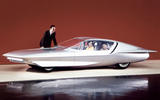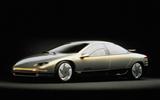 Slide of
Slide of
Some of the greatest cars ever seen are the ones that never went into production.
Some concept cars are total flights of fancy, while others have some sort of grasp on reality. Over the decades there have been thousands of concept cars produced, some of which have reached production (invariably in much watered-down form) while others were far too outlandish to hit the road. And America has long been in the vanguard.
Here we look at some of the American concepts that didn't make it but we wish they had, either because they were technically brilliant or – more likely – because they simply looked fantastic even if they were completely impractical, but we love them anyway:
 Slide of
Slide of
Buick Y-Job (1939)
The Y-Job wasn’t the world’s first concept car; it wasn’t (the Volvo-backed Venus Bilo got there in 1933), but it did put ace stylist Harley Earl, head of General Motors design, on the map. Undeniably forward-thinking, the Y-Job featured hidden headlights, electric windows and a powered roof, concealed under a hard tonneau.
 Slide of
Slide of
Buick Le Sabre (1951)
Had the Second World War not happened, we would have probably seen a bunch of interesting concept cars in the 1940s, but it did, so we had to wait until 1951 for the next notable one. The Le Sabre was another by Harley Earl (pictured), who used this as his everyday car once it was redundant on the show circuit. There was electric operation of the doors and windows along with a hard top that automatically raised itself in the event of rain.
 Slide of
Slide of
Lincoln XL500 (1953)
With push-button automatic transmission the XL-500 was supposed to provide effortless driving. The goldfish bowl problem presented by all that glass would be resolved by the then highly important emerging technology of air conditioning that it featured. Standard equipment also included a telephone and built-in jacks in the event of a puncture.
 Slide of
Slide of
Chevrolet EX-122 (1953)
Here’s one concept we really could never exclude from this list. As America boomed after the war, its appetite for playful cars that were more than just vehicular tools boomed with it, fuelling demand for small imported sports cars from the likes of MG and Alfa Romeo. Harley Earl responded with the prototype that would become the Corvette, and perhaps Chevy’s most celebrated model-line. The lightweight fibreglass-bodied concept was first shown at GM’s 1953 Motorama exhibition in New York, and the first 300 production models went on sale later that same year.
Early models were criticised for poor build quality and an underwhelming 150 hp straight-six. Giving the car some of the first examples of the new Chevy small block V8 in 1955, with 195 hp of power, changed everything for the better, and the rest is history.
 Slide of
Slide of
De Soto Adventurer II Coupé (1954)
The brief with this one was to come up with something super-slippery rather than ostentatious. As a result the Adventurer’s clean and elegant almost-Italian lines are very understated but those afterburner-inspired tail lights give a hint of what was to come from later Chrysler concepts.
 Slide of
Slide of
Lincoln Futura (1955)
Best known for its starring role in the original Batman TV series, the Futura deserves a place in this story for looking like nothing else thanks to its twin Plexiglass domes along with fins front and rear. Ford spent $250,000 (around $2.5 million in today’s money) building this 300bhp V8-powered running concept which also featured a push-button automatic transmission.
 Slide of
Slide of
Oldsmobile Golden Rocket (1956)
Nobody could keep up with the Americans in the 1950s, with one space-age creation appearing after another. The Golden Rocket packed a 275bhp punch from its 3.2-lite V8, and it introduced us to powered steering column adjustment. Its party piece though was the seats rose up and swivelled outwards when the doors were opened – and at the same time, the roof panels hinged upwards so it was easier to get in and out.
 Slide of
Slide of
GM Firebird III (1958)
Until now, most American concept cars of the 1950s had been inspired by jet aircraft but this was the first one to take its cues from rockets and space craft instead. As such it was even more extreme than its predecessors and featured automatic guidance, a 225bhp turbine, a climate-controlled cabin and automatic lighting.
 Slide of
Slide of
GM Runabout (1964)
Charming in its simplicity, the Runabout was a three-wheeled city car with the aerodynamics of an arrow. In the boot were two integral shopping trolleys so you could load up on cheap beer. Inside there was seating for five; two up front and three in the back.
 Slide of
Slide of
Buick Century Cruiser (1969)
Designed originally as the Firebird IV in 1964, this high-performance car was designed as an autonomous car with all of the comforts of a living room. As such the seats could recline and swivel, there was a TV and pull-out table and even a built-in fridge. Looking at the picture it’s hard to see how they fitted that lot in; it must have been very cosy inside... Its designers probably reckoned that by 2021 all new cars would look and work like this; not quite.
 Slide of
Slide of
Ford Probe IV (1983)
While its predecessor the Probe III entered production as the Sierra in Europe, the Probe IV never got anywhere near the showroom. That's rather a shame, because even now this ultra-slippery car still looks futuristic in a retro kind of way. If that's possible.
 Slide of
Slide of
Chrysler – Lamborghini Portofino (1987)
Chrysler made the Portofino concept largely to flaunt its acquisition of Lamborghini. Fully functional, the design study boasted two sets of scissor-style doors that opened in separate directions and a mid-mounted V8 engine borrowed from the Jalpa. If launched, it would have likely cost a small fortune and arrived as an expensive limited-edition model.
It wouldn’t have been a hit, unless we’re talking about the financial hit Chrysler would have taken after developing it, but a Chrysler built on a stretched Jalpa platform would make for a fascinating classic car in 2021. It would have elevated Chrysler’s image, too.
 Slide of
Slide of
GM Sunraycer (1987)
Some concepts are non-runners but not this one; GM sent it on a 1,950-mile journey across Australia fed by nothing but sunshine. Weighing just 177kg (289 lb) and fitted with 7,200 solar cells, the Sunraycer could seat just one so it wasn’t massively practical, but it was a technical tour de force with its lightweight construction, regenerative braking and an electric motor that was the size of a drinks can. Today, solar-panels are creeping into EVs to boost their ranges.
 Slide of
Slide of
GM CERV III (1990)
GM showed its first CERV (Chevrolet Engineering Research Vehicle) concept in 1962 and followed it up two years later. The third iteration was a very different beast and while it was a looker, it was the engineering that set it apart. The car’s raison d’etre was to be capable of being driven at massive speeds (200mph) without the need for super-human skills – even if driven on tricky or slippery surfaces. It also served to preview a new GM design language which would show up in production form in the Chevy Corvette C5 seven years down the road.
 Slide of
Slide of
Pontiac Sunfire (1990)
Pontiac towards the end of its life became totally lost in the brand-engineered GM world, but we reckon Pontiac's fate could have been so different if this 193 hp 2.4-liter family saloon had been put into production. It would certainly have got people talking about Pontiac again.
 Slide of
Slide of
Chrysler Atlantic (1995)
Heavily influenced by the wild looks of the 1937 Bugatti Atlantic, this fabulous art deco concept by Chrysler also shared similarities under the hood, as it was powered by a straight-8 engine created by joining two Neon four-cylinder units. Even to 2021 eyes it looks amazing.
 Slide of
Slide of
Plymouth Pronto Spyder (1998)
Chrysler was obsessed with retro designs at the end of the 20th century. Along with the Atlantic, we got the Prowler and PT Cruiser production cars, but few looked forward. Not the Pronto Spyder though, which appealed because of how pragmatic it was; as an attainable sportscar it featured a 228 hp four-cylinder engine, turbocharged and mounted in the middle of the car. The cab-forward stance and clean lines made it look appealing without any hint of ostentatiousness. Sadly, the Plymouth brand shut up shop just three years later.
 Slide of
Slide of
Dodge Razor (2002)
 Slide of
Slide of
Pontiac G6 Concept (2003)
Pontiac attempted to silence critics of its rental-car image when it showed this car at the 2003 Detroit motor show. Low, wide and sporty, it hinted the brand was about to turn itself around by injecting a double dose of performance and desirability into the Grand Am’s replacement.
The G6 Concept could have become Pontiac’s first truly desirable family car in decades. It didn’t; it arrived in showrooms in 2004 with a watered-down design and a front-wheel drive platform shared with the Chevrolet Malibu and the Saab 9-3.
 Slide of
Slide of
Cadillac Sixteen (2003)
 Slide of
Slide of
Mercury Messenger (2003)
The Messenger wasn’t cutting edge in either its technology or design, but we include it for its allure, in the kind of way that only a muscular coupé can. This Mercury featured a 306 hp 4.6-liter quad-cam Mustang-sourced V8. Designed by Gerry McGovern (now design chief at Land Rover), the Messenger was supposed to usher in a new era for Mercury but alas it was not to be. In 2010 the Messenger concept was auctioned off, just before the Mercury brand was closed down; one lucky collector got to secure the unique car for just $52,250.
 Slide of
Slide of
Lincoln Navicross (2003)
Although it looked just like any other large luxury sedan concept, the Navicross was much more than that as it was a sporty alternative to a full-blown SUV. Power came from a supercharged 4.2-liter V8 putting out somewhere in the region of 400 hp.
 Slide of
Slide of
Chrysler ME Four-Twelve (2004)
If only Chrysler hadn't been broke, this might have been a production reality. With its 6.0-liter 862 hp V12, Chrysler reckoned 250mph was in sight. So instead of a Bugatti on your drive you could have had a Chrysler. It might have done wonders for the brand’s image.
America has been the source of some of the most interesting and notable concept cars – here are the ones we reckon are the best
Advertisement







